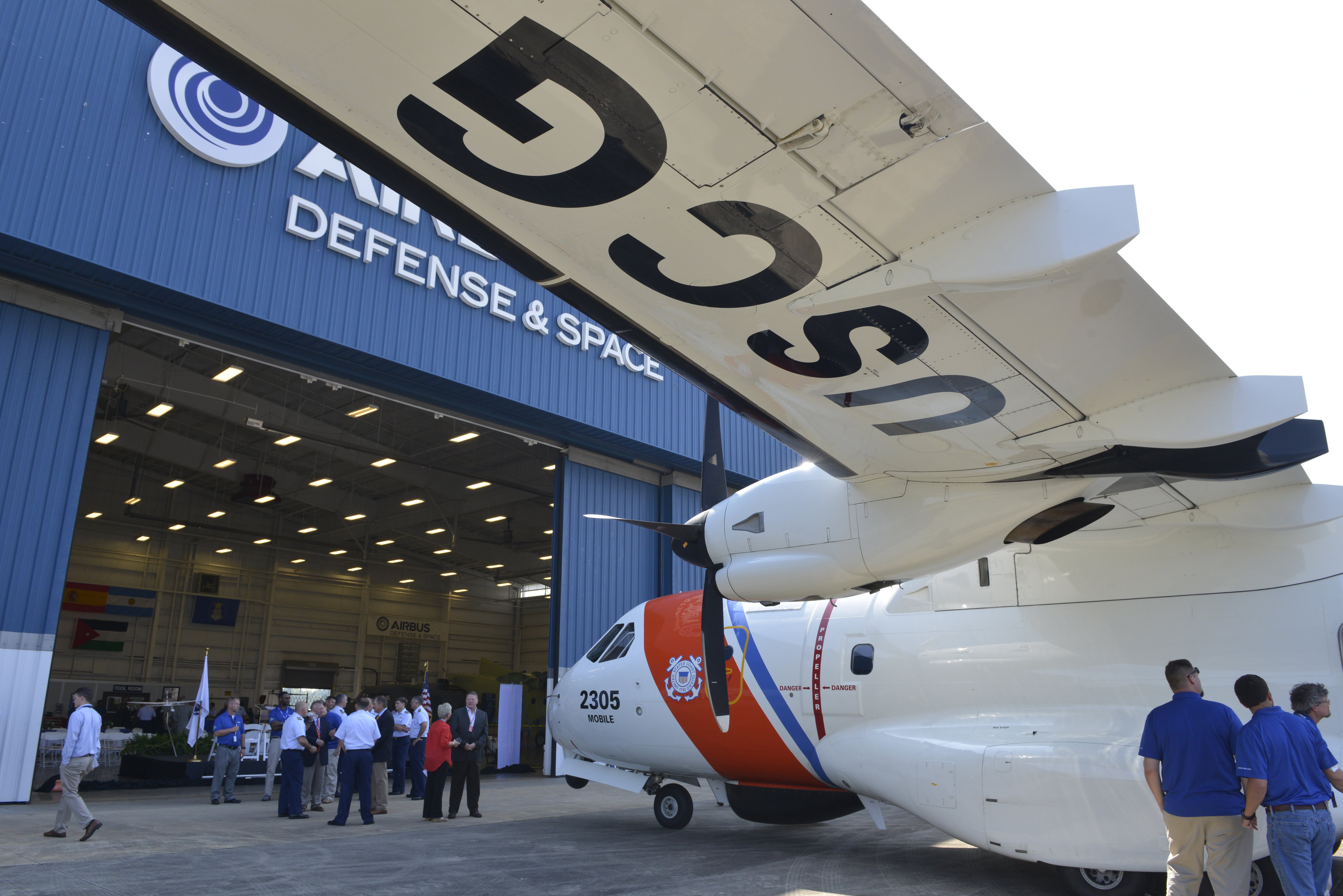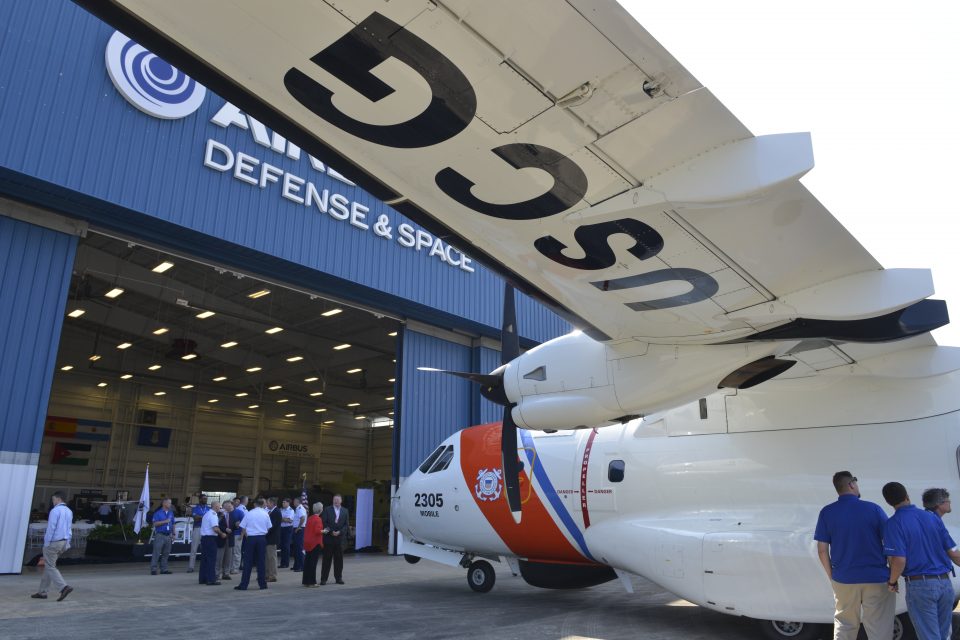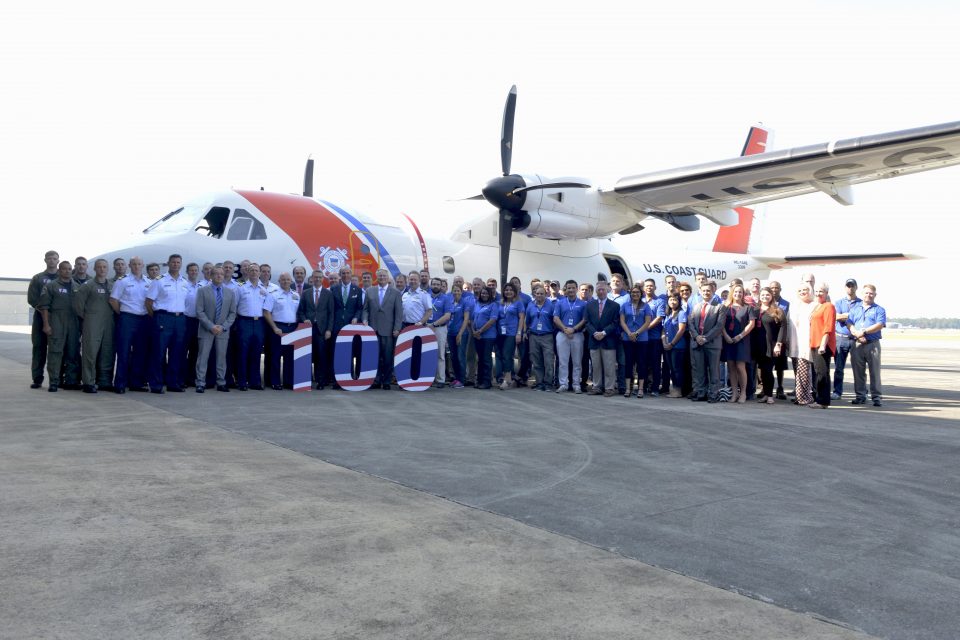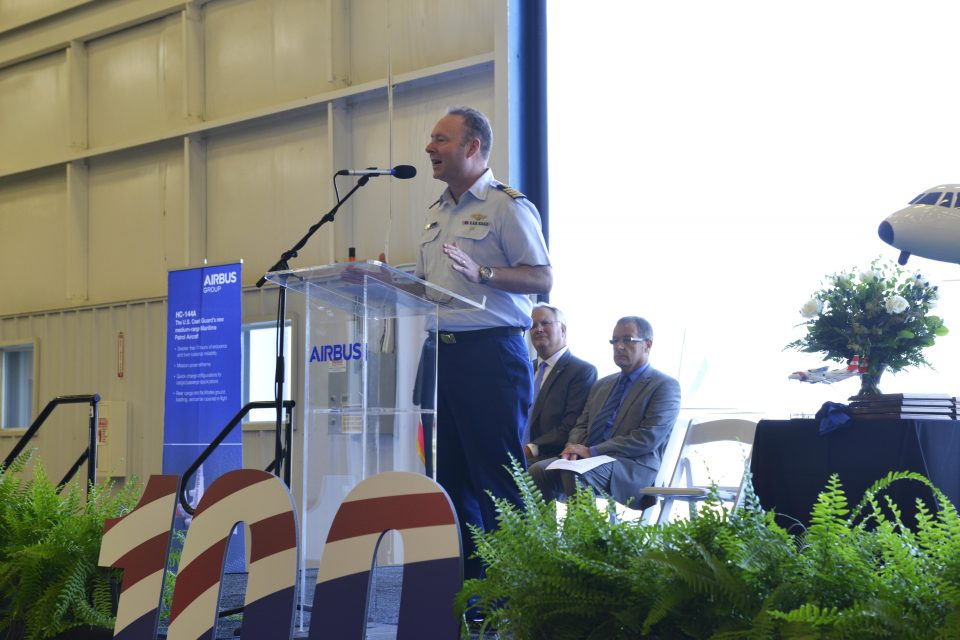2017-09-25 Several years ago we visited a key USCG air base where the new Ocean Sentry patrol aircraft had just arrived for service.
We have reposted that interview done in 2010 below.
But fast forward to 2017, and that aircraft has now reached a flight hour milestone.
In a ceremony held on September 22, 2017, at Airbus Defense and Space in Mobile Alabama, the Coast Guard’s HC-144 Ocean Sentry aircrafts collectively reaching 100,000 flight hours was celebrated.
Personnel from the Coast Guard, and Airbus Defense and Space, Sandy Stimpson, Mayor of Mobile, and Jerry Carl, Mobile County Commissioner were in attendance.
MOBILE, AL, UNITED STATES
09.22.2017
U.S. Coast Guard District 8
Seven years ago, the Ocean Sentry had just come to Air Station Miami and we interviewed the leadership and staff at Air Station Miami and this is what they had to say about the coming of the Ocean Sentry to their area of operational interest.
SLD talked recently with the USCG Miami Air Station Commander and staff about their AOR, their con-ops and the coming addition of the latest USCG aircraft, the Ocean Sentry.
The Air Station faces a challenging AOR in which there is significant maritime and air traffic which shapes commerce, law enforcement and environmental challenges.
Dealing with illegal immigration and drug trafficking is a major concern and because many of these migrants come from outside the region, in areas of known terrorist activity, even “normal” immigration issues carry with them national security concerns.
The interview covered a wide range of issues, but the comments selected here largely deal with the question of the use of aircraft in the region and how the new aircraft will be introduced and re-shape operations in the AOR.
SLD: How many aircraft do you have at the air station currently?
Captain Richard Kenin, Commanding Officer of the USCG, Air Station, Miami:
Right now, we have 10 aircraft.
When I was here in 1991, we had 21 aircraft at this unit.
We now have 10 aircraft with this unit.
SLD: You had 21?
Captain Kenin: We had 21 aircraft here in 1991 when I was here before and we now have 10.
SLD: And presumably, the geographical area has not shifted?
Captain Kenin: No. What has shifted is the interdiction mission has shifted to Jacksonville, and our helicopters were sent away.
But those helicopters did a lot more than just drug interdiction. They did all the other missions for the air station.
So they really downsized, redesignated the air station in favour of standing up the single mission unit,
Captain Kenin: We are phasing out the Falcons in favor of the Ocean Sentry.
Our first
Falcon has already left.
So we now have 5 of these and as the HC144’s come online, these aircraft will depart.
Notice up there, we have 430 days away from home station (DAHS). We have an aircraft deployed 24/7 somewhere down in the Caribbean.
So we typically have 4 aircrafts here and on a good day, we have 3 of those aircrafts available for flying. We will pluck up that one.
The 144, you saw it out there is coming online here.
We are predicting to be, we are going to be initially operational kickboard with that aircraft in October 1st.
Which means we will be flying both the FALCON and the CASA together during our ready search and rescue mission as well as deploying.
And that will be the 1st of October; we will be planning on that.
And by then we will have 3 aircraft,.
By next October when we will have only 144’s.
The long-range plan as you probably know is that we are going to have 7 of those aircrafts here.
Now they are saying 5 aircraft.
Some people are saying that might be 3 aircraft.
SLD: What are the major threats which you face in your AOR?

The first Ocean Sentry MPA for the Miami Air Station IOC October 2010
Captain Kenin: We have to cover a large and busy AOR with these aircraft in any case and face a diversity of threats. Probably the biggest threat right now for us is migrants.
And the threat is not the Cuban migrant coming up from Cuba. They come across for economic reasons; that is really not a threat.
The real threat for us from a Homeland Security perspective is people coming over from the Bahamas.
It is very easy to get into the Bahamas, and then it is only 40 miles across from the Bahamas to the US. We have picked up loads, boatloads of Sri Lankans, of Nigerians, Pakistanis, these are people with the national security threat that we are really concerned about.
The 40 miles from Bimini, it is an hour and a half. Obviously, there is a serious threat from a search and rescue perspective as well.
SLD: Obviously a key element of dealing with this challenge is providing for the ISR to find the threats and then having the surface assets to prosecute the threats.
How will you shape your ISR mission with the new aircraft?
Captain Kenin: The HU-25 when it came online in 1980 was designed for a mission that we do not have anymore.
At that time, the thought was that we are going to search out of search and rescue. And so we need an aircraft that could go out through location, locate the vessel in distress quickly and then the helicopter would find then pick them out the water.
And it was designed for that, and it did it very well. It had very good sprint capacity to do search and rescue at distance. It had great dash speed, and it was designed for a minimal amount of loiter time and then come back.
SLD: And presumable then you are saving the cost of the surface ship as well by using this aircraft.

The Cockpit of the Ocean Sentry
Captain Kenin: Exactly.
You had a plane that was the taking the search out of search and rescue.
The Coast Guard air force does it all. And that was the leadership’s thought in pushing us towards a jet and it did that mission very well.
And it also did the mission that we moved into with air interdiction very well when we started interdicting drug smugglers it did that very well with a different radar.
But now the Coast Guards mission for its fixed-wing aircraft has changed.
We are now about maritime patrol. And that aircraft does not have the endurance. It can give you the legs.
But it cannot give you the endurance to do the new Coast Guard mission.
We needed an aircraft that has the sophisticated sensor packages.
So what we have done all the years is with all the different things on that aircraft, making the aircraft much more complicated. The avionic system was much more complex, I mean it takes more maintenance and care to operate and it has many add on capabilities.

Inside the Ocean Sentry: “The Ocean Sentry unlike the Falcon has significant cargo space.”
SLD: But these capabilities were not integrated on the Falcon?
Captain Kenin: And not integrated. We have hung more things on them. Individually, these packages are good. It is good radar, it is a good FLIR, but they do not integrate well, and the aircraft just cannot stay out there long enough to do the mission.
And when we find a go fast mover across from somewhere, we cannot stay on scene with that aircraft to get the surface fleet to react and make the interdiction.
We can find it and we do it pretty well. But after we find it, if we have already been flying 2-1/2 hours, well, all we can do is report a position and then go back and get fuel.
The Falcon was optimized for a particular mission set and what you are talking about now is that you have a multi mission set which the Ocean Sentry can execute.
So you are saying maybe saying that the aircraft is out there to maybe when it launched, it had a certain responsibility for search and rescue or ISR supporter of drug interdiction.
But when it is out there, it does not have to come back to do the next mission, it is there and you can shift it seamlessly to, well now we have an emergency search and rescue over here, would you support that presumed that you can pass it off from service ship to service ship.
It should be passed on functionally.
SLD: Presumably multi mission in terms of not just ISR but multi mission in terms of lift and carry as well.
Captain Kenin: Yes.
That gives you a lot of the flexibility given that you are a smaller air force yet a lot of flexibility built into the new aircraft.
Multi mission is huge especially in this AOR because there is so many different places that you go and need to shift tasks in flight….
SLD: The CASA aircraft was designed in part to operate in the Mediterranean and the Caribbean has a great deal of similarity, I would assume that the fit is pretty good.
Captain Kenin: It is and we need the loiter time this aircraft has.
We really need the airplane that can stay out 7 or 8 hours and that is important for a number of different reasons.
First is that you can actually cover the ground that you need to.
Second, it takes a long time for the ship to get there. And we have problems in the past when I found the ship, but now I had to leave and now we lost it.
And then by the time the ship or another asset comes, whether it would be CBP or another Coast Guard asset, it is difficult to find they are gone.
And we play a lot of cat and mouse with smugglers in the Caribbean overseas, so it is important to be able to find these folks because they will try to dodge and hide until we are forced to leave
SLD: So the multi-mission capabilities of the aircraft coupled with the loiter time of the aircraft fits your AOR and you multi-mission con-ops pretty well?
Captain Kenin: We believe so.
Our resources are multi-mission, our people are multi-mission.
And the Navy and DOD and the other services have that luxury of having specialized people.
But our guy is doing that and he is running up front dropping a pump, he is going back to fill the aircraft.
He is doing all this other kind of stuff.
SLD: How would you describe the challenge moving forward?
Captain Kenin: We have been given a new aircraft, and everybody is excited.
We all agree this is going to give us a lot more capability than the Falcon.
But how do we mould and change our operations to still meet the operational commander expectations with this new aircraft?
And that is something that we are developed in as we train on it and we will learn how to use it and learn what the capabilities are and have an ability to operate at a much smaller runway is huge.
We can go places we have never been able to go before…..
———–
*** Posted on June 9th, 2010





